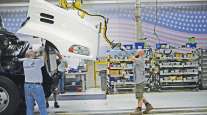Senior Reporter
Class 8 Orders in January Clear 40,000

[Stay on top of transportation news: Get TTNews in your inbox.]
North American Class 8 orders kicked off the year by reaching 42,200 in January, up 146% from a year earlier when they were 17,204, ACT Research reported, citing truck makers’ initial data.
“These orders were kind of a continuation of a theme: surprise to the high side,” said ACT Research Vice President Steve Tam. “We as an industry need to recalibrate our expectations. Maybe we need to look higher.”
The preliminary net total also was down 17% compared with 50,739 in December, and 19% from 52,104 in November, according to ACT.
Preliminary NA Class 8 net orders in January were 42,200 units, down 17% from December, but a 146% improvement from year-ago January.https://t.co/WgJap6L2Pv#truck #semitruck #trucking #transportation pic.twitter.com/Q0dJyfHEhj — ACT Research (@actresearch) February 3, 2021
He said the January orders reflected a “competition” for remaining build slots as the order board fills and production “tries” to ramp up to meet that.
At the same time, Class 8 build rates on a per-day basis have been “pedestrian,” Tam said. “We finished the year at just over 1,100 units a day, which is OK. But if you annual that, based on 235 build days a year, it’s a 258,500 market. Clearly, the industry has the capacity to go higher.”
He said even with the ramping up truck makers have in mind to meet demand, backlog will continue to mount until things revert a little bit after the first quarter when order rates are likely to cool.
ACT is looking for a 40% increase in production in 2021 compared with 2020.
And production faces some potential challenges, he added, including availability of steel, tires and microchips, although with chips, these may be more in the automotive and consumer sectors. “I was talking with one supplier and they said the price of steel has doubled in the last six months, and there is a lot of steel content in a Class 8 truck.”
Tam said truck makers may have agreements that hedge against price increases.
Both Meritor Inc. and Cummins Inc. separately said the supply chain is stressed.
“But clearly, it is going to be a good year. Underlying fundamentals support that,” Tam said.
One fleet executive said ordering new trucks has two main benefits.
They enhance driver recruitment and “show our customers that we have the premium equipment they can rely on as part of doing business with us,” Matt Heroux, founder and president of Phoenix-based Fresh Freight, told Transport Topics.
Fresh Freight operates 15 Peterbilt 579 UltraLoft models and plans to add another 15 of the same model this year through its relationship with Rush Truck Centers in Phoenix.

Heroux
He said he has reconfigured the company’s preferred spec on his upcoming new trucks that will haul produce across the West and Northwest. Safety and performance features are always the first things he looks for, but in conversations with drivers, the biggest thing they sought was increased personal storage.
“We changed our spec to go from a double bunk being we don’t run a lot of teams. So we converted to those with a single-driver occupancy in mind. We got rid of the top bunk and replaced that with overhead storage,” he said. “We reconfigured the power inverter a little bit to get them storage and added an extra door to the jockey box, the exterior storage compartment. And we extended the closet a little bit just trying to find a way for the driver to feel a little more comfortable.”
Heroux delayed an order in 2020 “with all that was going on with the pandemic.”
FTR pegged preliminary net orders at 42,833.
Don Ake, vice president of commercial vehicles at FTR, agreed the market may face some supply chain restrictions in the first quarter.
“If you can’t build everything people need in the first quarter, then that [production] just keeps moving out into the year,” he added. “It keeps capacity tight and keeps rates elevated, especially spot rates.”
Experts say the Class 8 replacement level in North America is 19,500 orders a month.
One large fleet pointed to the driver shortage as a means of understanding what the orders reflect.
USXpress Market Forecast by Transport Topics
“While the recent uptick in Class 8 orders suggests that additional truckload capacity will be realized soon, driver shortages will persist for the foreseeable future,” U.S. Xpress Enterprises Inc. wrote in its 2021 Economic Outlook Forecast.
“The sheer number of drivers in the industry will determine whether those new tractor orders will serve as asset replacement or growth. The structural barriers to driver employment will likely keep capacity in check for the time being,” the forecast noted.
U.S. Xpress Enterprises Inc. ranks No. 24 on the Transport Topics Top 100 list of the largest for-hire carriers In North America. It ranks No. 31 on the TT list of the 50 largest logistics companies in North America.
Want more news? Listen to today's daily briefing below or go here for more info:




